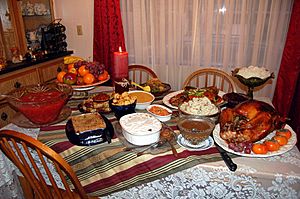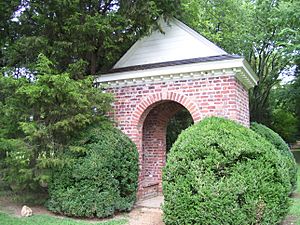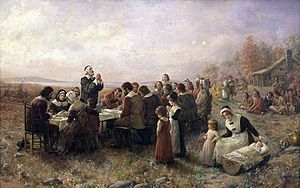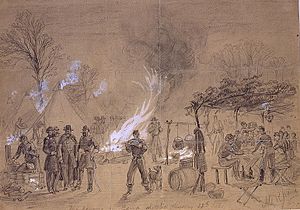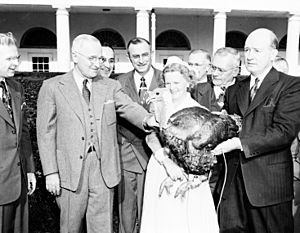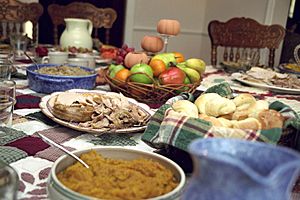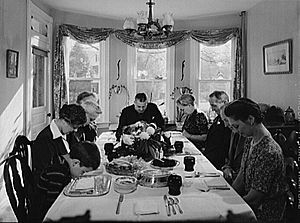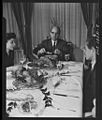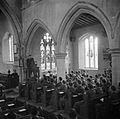Thanksgiving (United States) facts for kids
Quick facts for kids United States Thanksgiving |
|
|---|---|
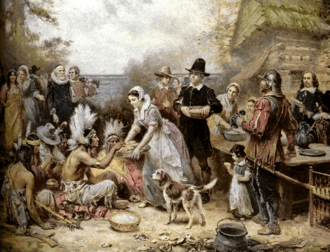
The First Thanksgiving, painting by Jean Leon Gerome Ferris (1863–1930)
|
|
| Observed by | United States |
| Type | National |
| Celebrations | parades, spending time with family, football games, eating large meals |
| Date | fourth Thursday in November |
| 2025 date | November 27, 2025 |
Thanksgiving, or Thanksgiving Day, celebrated on the fourth Thursday in November, at the end of the harvest season, is an annual American public holiday to express thanks for one's material and spiritual possessions.
Most people celebrate by gathering at home with family or friends for a holiday feast. Though the holiday's origins can be traced to harvest festivals which have been celebrated in many cultures since ancient times, the American holiday has religious undertones related to the deliverance of the English settlers by Native Americans after the brutal winter at Plymouth, Massachusetts.
History
Spaniards
The first recorded Thanksgiving ceremony took place on September 8, 1565, when 600 Spanish settlers, under the leadership of Pedro Menéndez de Avilés, landed at what is now St. Augustine, Florida, and immediately held a Mass of Thanksgiving for their safe delivery to the New World; there followed a feast and celebration. As the La Florida colony did become part of the United States, this can be classified as the first Thanksgiving.
The Spanish colonial town of San Elizario (San Elceario), near El Paso, Texas, has also been said to be the site of the first Thanksgiving to be held in what is now known as the United States, though that was not a harvest festival. Spaniard Don Juan de Oñate ordered his expedition party to rest and conducted a mass in celebration of thanksgiving on April 30, 1598.
The Virginia colony
A collective prayer of thanksgiving was led by Captain John Woodlief in the Virginia Colony on December 4, 1619 near the current site of Berkeley Plantation, where celebrations are still held each year in November. Woodleif addressed the 38 men with: "We ordaine that the day of our ships arrival at the place assigned for plantation in the land of Virginia shall be yearly and perpetually kept holy as a day of Thanksgiving to Almighty God."
The Pilgrims
The Pilgrims were particularly thankful to Squanto, the Native American who taught them how to catch eel, grow corn and who served as an interpreter for them (Squanto had learned English as a slave in Europe and travels in England). Without Squanto's help the Pilgrims might not have survived in the New World. The explorers who later came to be called the "Pilgrims" set apart a day to celebrate at Plymouth immediately after their first harvest, in 1621. At the time, this was not regarded as a Thanksgiving observance; harvest festivals were existing parts of English and Wampanoag tradition alike.
The Pilgrims did not hold a true Thanksgiving until 1623, when it followed a drought, prayers for rain, and a subsequent rain shower. Irregular Thanksgivings continued after favorable events and days of fasting after unfavorable ones. In the Plymouth tradition, a thanksgiving day was a church observance, rather than a feast day.
Gradually, an annual Thanksgiving after the harvest developed in the mid-17th century. This did not occur on any set day or necessarily on the same day in different colonies in America.
The Massachusetts Bay Colony (consisting mainly of Puritan Christians) celebrated Thanksgiving for the first time in 1630, and frequently thereafter until about 1680, when it became an annual festival in that colony; and Connecticut as early as 1639 and annually after 1647, except in 1675. The Dutch in New Netherland appointed a day for giving thanks in 1644 and occasionally thereafter.
Charlestown, Massachusetts held the first recorded Thanksgiving observance June 29, 1671 by proclamation of the town's governing council.
During the 18th century individual colonies commonly observed days of thanksgiving throughout each year. We might not recognize a traditional Thanksgiving Day from that period, as it was not a day marked by plentiful food and drink as is today's custom, but rather a day set aside for prayer and fasting.
Later in the 1700's individual colonies would periodically designate a day of thanksgiving in honor of a military victory, an adoption of a state constitution or an exceptionally bountiful crop. Such a Thanksgiving Day celebration was held in December of 1777 by the colonies nationwide, commemorating the surrender of British General Burgoyne at Saratoga.
The Revolutionary War to nationhood
During the American Revolutionary War the Continental Congress appointed one or more thanksgiving days each year, each time recommending to the executives of the various states the observance of these days in their states. The First National Proclamation of Thanksgiving was given by the Continental Congress in 1777.
George Washington, leader of the revolutionary forces in the American Revolutionary War, proclaimed a Thanksgiving in December 1777 as a victory celebration honoring the defeat of the British at Saratoga.
Thanksgiving proclamations in the first thirty years of nationhood
As President, on October 3, 1789, George Washington made proclaimed and created the first Thanksgiving Day designated by the national government of the United States of America. George Washington again proclaimed a Thanksgiving in 1795.
President John Adams declared Thanksgivings in 1798 and 1799. No Thanksgiving proclamations were issued by Thomas Jefferson but James Madison renewed the tradition in 1814, in response to resolutions of Congress, at the close of the War of 1812. Madison also declared the holiday twice in 1815; however, none of these were celebrated in autumn. In 1816, Governor Plamer of New Hampshire appointed Thursday, November 14 to be observed as a day of Public Thanksgiving and Governor Brooks of Massachusetts appointed Thursday, November 28 to be "observed throughout that State as a day of Thanksgiving."
A thanksgiving day was annually appointed by the governor of New York from 1817. In some of the Southern states there was opposition to the observance of such a day on the ground that it was a relic of Puritanic bigotry, but by 1858 proclamations appointing a day of thanksgiving were issued by the governors of 25 states and two territories.
Lincoln and the Civil War
In the middle of the American Civil War, President Abraham Lincoln, prompted by a series of editorials written by Sarah Josepha Hale, proclaimed a national Thanksgiving Day, to be celebrated on the final Thursday in November 1863.
Since 1863, Thanksgiving has been observed annually in the United States.
1939 to 1940
Abraham Lincoln's successors as president followed his example of annually declaring the final Thursday in November to be Thanksgiving. But in 1939, President Franklin D. Roosevelt broke with this tradition. November had five Thursdays that year, and Roosevelt declared the fourth Thursday as Thanksgiving rather than the fifth one. In 1940, in which November had four Thursdays, he declared the third one as Thanksgiving. Although many popular histories state otherwise, he made clear that his plan was to establish it on the next-to-last Thursday in the month instead of the last one. With the country still in the midst of The Great Depression, Roosevelt thought an earlier Thanksgiving would give merchants a longer period to sell goods before Christmas. Increasing profits and spending during this period, Roosevelt hoped, would help bring the country out of the Depression. At the time, advertising goods for Christmas before Thanksgiving was considered inappropriate.
However, many localities had made a tradition of celebrating on the last Thursday, and since a presidential declaration of Thanksgiving Day was not legally binding, it was widely disregarded. Twenty-three states went along with Roosevelt's recommendation, 22 did not, and some, like Texas, could not decide and took both weeks as government holidays. Critics termed Roosevelt's dating of the holiday as "Franksgiving."
1941 to present
The U.S. Congress in 1941 split the difference and passed a bill requiring that Thanksgiving be observed annually on the fourth Thursday of November, which was sometimes the last Thursday and sometimes (less frequently) the next to last. On December 26 of that year President Roosevelt signed this bill, for the first time making the date of Thanksgiving a matter of federal law.
Since 1947, or possibly earlier, the National Turkey Federation has presented the President of the United States with one live turkey and two dressed turkeys, in a ceremony known as the National Thanksgiving Turkey Presentation. The live turkey is pardoned and lives out the rest of its days on a peaceful farm. While it is commonly held that this pardoning tradition began with Harry Truman in 1947, the Truman Library has been unable to find any evidence for this. The earliest on record is with George H. W. Bush in 1989. Still others claim that the tradition dates back to Abraham Lincoln pardoning his son's pet turkey. Both stories have been quoted in more recent presidential speeches. In more recent years, two turkeys have been pardoned, in case the original turkey becomes unavailable for presidential pardoning.
Since 1970, a group of Native Americans and other assorted protesters (mostly of progressive political persuasion) have held a National Day of Mourning protest on Thanksgiving at Plymouth Rock in Plymouth, Massachusetts in the name of social equality and in honor of political prisoners.
Traditional celebrations
Foods of the season
U.S. tradition compares the holiday with a meal held in 1621 by the Wampanoag and the Puritans who settled in Plymouth, Massachusetts. This element continues in modern times with the Thanksgiving dinner, often featuring turkey, playing a large role in the celebration of Thanksgiving. Some of the details of the American Thanksgiving story are myths that developed in the 1890s and early 1900s as part of the effort to forge a common national identity in the aftermath of the Civil War and in the melting pot of new immigrants.
In the United States, certain kinds of food are traditionally served at Thanksgiving meals. First and foremost, baked or roasted turkey is usually the featured item on any Thanksgiving feast table (so much so that Thanksgiving is sometimes referred to as "Turkey Day"). Stuffing, mashed potatoes with gravy, sweet potatoes, cranberry sauce, sweet corn, other fall vegetables, and pumpkin pie are commonly associated with Thanksgiving dinner. All of these primary dishes are actually native to the Americas or were introduced as a new food source to the Europeans when they arrived. As an alternative to turkey, many vegetarians or vegans eat tofurky, a meatless turkey made of tofu. To feed the needy at Thanksgiving time, most communities have annual food drives that collect non-perishable packaged and canned foods, and corporations sponsor charitable distributions of staple foods and Thanksgiving dinners.
Giving thanks
Thanksgiving was originally a religious observance for all the members of the community to give thanks to God for a common purpose. Historic reasons for community thanksgivings include the 1541 thanksgiving mass after the expedition of Coronado safely crossing part of Texas and finding game, The only presidents to inject a specifically Christian focus to their proclamation have been Grover Cleveland in 1896,
The tradition of giving thanks to God is continued today in various forms. Religious and spiritual organizations offer services and events on Thanksgiving themes the week-end before, the day of, or the week-end after Thanksgiving. Bishop Ryan observed about Thanksgiving Day, "It is the only day we have that consistently finds Catholics at Mass in extraordinary numbers...even though it is not a holy day of obligation."
In celebrations at home, it is a holiday tradition in many families to begin the Thanksgiving dinner by saying grace. Found in diverse religious traditions, grace is a prayer before or after a meal to express appreciation to God, to ask for God’s blessing, or in some philosophies, to express an altruistic wish or dedication. The custom is portrayed in the photograph “Family Holding Hands and Praying Before a Thanksgiving Meal.” The grace may be led by the hostess or host, as has been traditional, or, in contemporary fashion, each person may contribute words of blessing or thanks.
Vacation and travel
On Thanksgiving Day, families and friends usually gather for a large meal or dinner, the result being that the Thanksgiving holiday weekend is one of the busiest travel periods of the year. In the United States, Thanksgiving is a four-day or five-day weekend vacation in school and college calendars. Most business and government workers (78% in 2016) are also given both Thanksgiving and the day after as paid holidays. Thanksgiving Eve, on the Wednesday night before, has been one of the busiest nights of the year for bars and clubs, both in terms of sales and volume of patrons, as many students have returned to their hometowns from college.
Parades
In New York City, the Macy's Thanksgiving Day Parade (often erroneously referred to as the "Macy's Day Parade") is held annually every Thanksgiving Day from the Upper West Side of Manhattan to Macy's flagship store in Herald Square, and televised nationally by NBC. The parade features parade floats with specific themes, scenes from Broadway plays, large balloons of cartoon characters and TV personalities, and high school marching bands. The float that traditionally ends the Macy's Parade is the Santa Claus float, the arrival of which unofficially signifies that the Christmas season has begun.
Thanksgiving parades also appear in many other cities, including:
- Chicago, Illinois (McDonald's Thanksgiving Parade)
- Philadelphia, Pennsylvania (6abc IKEA Thanksgiving Day Parade), claims to be the oldest parade, launched in 1920
- Plymouth, Massachusetts (America's Hometown Thanksgiving Parade), held the Saturday before Thanksgiving
- Houston, Texas (H-E-B Holiday Parade)
- St. Louis, Missouri (Ameren St. Louis Thanksgiving Parade)
- Detroit, Michigan (America's Thanksgiving Parade)
- Seattle, Washington
- Fountain Hills, Arizona
- Stamford, Connecticut (UBS Parade Spectacular), held the Sunday before Thanksgiving, designed as a complement to the Macy's parade
- Nicollet Mall, Minneapolis, Minnesota (Target Holidazzle Parades), a series of parades that begin the Friday after Thanksgiving
- Pittsburgh, Pennsylvania (Celebrate the Season Parade)
The Pittsburgh and Minneapolis parades are co-sponsored by Macy's.
Shopping
The American winter holiday season (generally the Christmas shopping season in the U.S.) traditionally begins the day after Thanksgiving, known as "Black Friday", although most stores actually start to stock for and promote the December holidays immediately after Halloween, and sometimes even before.
Football
American football is often a major part of Thanksgiving celebrations in the United States. Professional games are traditionally played on Thanksgiving Day; until recently, these were the only games played during the week apart from Sunday or Monday night. The National Football League has played games on Thanksgiving every year since its creation; the tradition is referred to as the Thanksgiving Classic. The Detroit Lions have hosted a game every Thanksgiving Day since 1934, with the exception of 1939–1944 (due to World War II). The Dallas Cowboys have hosted every Thanksgiving Day since 1966, with the exception of 1975 and 1977 when the then-St. Louis Cardinals hosted (the Cowboys and Cardinals faced each other, in Dallas, in 1976). Since 2006 three games are played on Thanksgiving Day, with the third not having a set host team. The American Football League also had a Thanksgiving Classic since its founding in 1960, with its 8 founding teams rotating one game each year (two games after the AFL-NFL merger).
The mid-afternoon timing of televised professional football games has often lured family members away from the traditional Norman Rockwell-esque Thanksgiving table, impelling them to bring their dinner plates in front of the television. This has sometimes had the effect of converting the mood of the holiday from a family dinner revolving around mealtime conversation to something resembling a Super Bowl party, much to the dismay of mothers and other traditionalists.
For many college football teams, the regular season ends on Thanksgiving weekend, and a team's final game is often against a regional or historic rival. Most of these college games are played either on Friday or Saturday immediately after Thanksgiving, but usually a single college game is played on Thanksgiving itself.
Date
Since being fixed at the fourth Thursday in November by law in 1941, the holiday in the United States can occur as early as November 22 to as late as November 28. When it falls on November 22 or 23, it is not the last Thursday, but the second to last Thursday in November. As it is a Federal holiday, all United States government offices are closed and employees are paid for that day. It is also a holiday for the New York Stock Exchange, and also for most other financial markets and financial services companies.
Friday after Thanksgiving
The Friday after Thanksgiving, although not a Federal holiday, is often a company holiday for many in the U.S. workforce, except for those in retail. It is also a day off for most schools. The Friday after Thanksgiving is popularly known as Black Friday, so-called because of the heavy shopping traffic on that day. Black Friday is considered to be the start of the Christmas shopping season..
Advent (Christmas) season
The secular Thanksgiving holiday also coincides with the start of the four week Advent season before Christmas in the Western Christian church calendars. Advent starts on the 4th Sunday before Christmas Day on December 25; in other words, the Sunday between November 27 and December 3 inclusive.
Related pages
| U.S. federal holidays |
|---|
| New Year's Day | Martin Luther King, Jr. Day | Presidents' Day | Memorial Day | Independence Day Labor Day | Columbus Day | Veterans Day | Thanksgiving Day | Christmas Day |
Images for kids
-
"Pilgrims" are often confused with "Puritans". This sculpture The Pilgrim by Augustus St. Gaudens is based on his earlier work The Puritan
-
Servicemen eating a Thanksgiving dinner after the end of World War I (1918)
-
Dr. Mordecai Johnson, president of Howard University, serving portions of Thanksgiving turkey to members of his family in 1942.
-
U.S. Army serviceman dressed in a turkey costume leads the Kabul Satellite Turkey Chase 10K Run on Thanksgiving Day, 2011
-
John F. Kennedy unofficially spares a turkey on November 19, 1963. The practice of "pardoning" turkeys in this manner became a permanent tradition in 1989.
-
U.S. President George W. Bush visits Iraq to have Thanksgiving dinner with soldiers in November 2003
See also
 In Spanish: Día de Acción de Gracias para niños
In Spanish: Día de Acción de Gracias para niños


